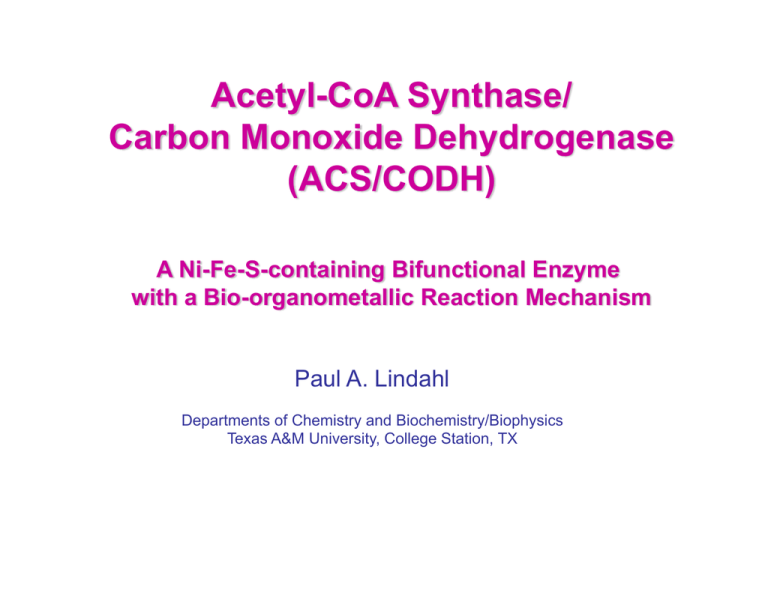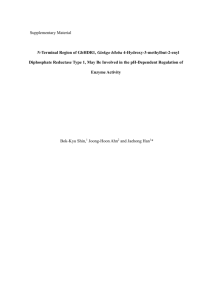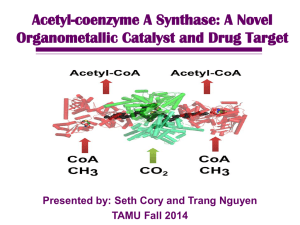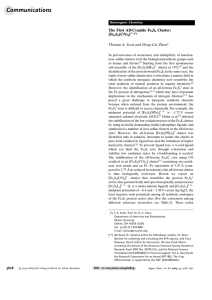Acetyl-CoA Synthase/ Carbon Monoxide Dehydrogenase (ACS/CODH) A Ni-Fe-S-containing Bifunctional Enzyme
advertisement

Acetyl-CoA Synthase/
Carbon Monoxide Dehydrogenase
(ACS/CODH)
A Ni-Fe-S-containing Bifunctional Enzyme
with a Bio-organometallic Reaction Mechanism
Paul A. Lindahl
Departments of Chemistry and Biochemistry/Biophysics
Texas A&M University, College Station, TX
Where are ACS/CODH’s found?
•Anaerobic Bacteria and Archaea
•Chemoautotrophic (grows on CO2/H2 or CO)
•Evolutionarily primitive (thermophiles)
•Major role in global C1 cycle
• Three major classes
• α2β2 + CoFeSP (γδ) Moorella thermoacetica
Methanosarcina thermophila
• (αβγδε)2
• β2
Rhodospirillum rubrum
Reactions catalyzed by the 310 kDa α2β2 tetramer
From Moorella thermoacetica:
CO/CO2 Redox (β Subunit): (CODH)
CO2 + 2H+ + 2e-
CO + H2O
Acetyl-CoA Synthesis (α subunit):
(ACS)
CH3--Co3+FeSP + CO + CoA
O
CH3-C-SCoA + Co1+FeSP
Recombinant α subunit also catalytic if incubate apo-α with Ni
Structure of ACS/CODH
Alpha Subunit
Open Conformation
A-Cluster (Active
site for ACS reaction)
Beta Subunits
C-Cluster (Active site
For CODH reaction)
Doukov et al.,Science 2002
Darnault et al, Nature Structural Biology, 2003
Alpha Subunit
Closed Conformation
Mechanism of the CODH Reaction
Controversy: Role of Bridging Sulfide in C-cluster
?
Carboxydothermus hydrogenoformans
Dobbek, Svetlitchnyi, Gremer, Huber, Meyer
(2001) Science 293, 1281-1285.
Moorella thermoacetica
Doukov, Iverson, Saravalli, Ragsdale, Drennan,
(2002) Science 298, 567-572.
Darnault, Volbeda, Kim, Legrand, Vernede, Lindahl, Fontecilla-Camps
(2003) Nature Structural Biology 10, 271-279.
Proposal of Dobbek, Svetlitchnyi, Liss and Meyer (JACS 2004):
•Bridging Sulfide is Required for Activity
•Incubation in CO abstracts S, forming COS and inactivating CODH
Dithionite, N2
CO + DTT
CO
Dobbek, Svetlitchnyi, Liss, Meyer
J. Am. Chem. Soc., 126 (17), 5382 -5387, 2004.
CO + Ti(III)citrate
We tried the same experiment…
CO
Ar
Feng and Lindahl
J. Am. Chem. Soc., 126 (17), 5382 -5387, 2004.
CO + 2MV2+ CO2 + 2MV1+ + 2H+
0.0 μM HS-
•CODHRr incubated in HSthen assayed
0.25 μM HS-
•HS- inhibited catalysis
0.50 μM HS-
•Inhibition was partial
1.25 μM HS-
•Lag phase evident
•HS- bound CODH prior to catalysis,
Yielding an inhibited state
•HS- is expelled, and rebinds
during turnover
2.5 μM HS5.0 μM HS10 μM HS100 μM HS-
Absorbance due to MV1+ (578 nM)
CO Oxidation Activity of
CODHRr in the Presence of
Sodium Sulfide
EPR = Electron Paramagnetic Resonance
Can observe systems with S = ½, 3/2, 5/2, etc
Ms at E+ = +1/2gβH Axial Symmetry (g║ > g┴)
E,
Potential
Energy
ΔE = hυ=gβH
S = 1/2
Ms at E- = -1/2gβH
Axial Symmetry (g┴>g║)
H, Magnetic Field
Abs
Isotropic Symmetry
dAbs
dH
Quantified by Integration
and comparison to
Cu(II)EDTA standard
Rhombic Symmetry
(gx ≠gy ≠gz)
H
Principal g-value
g = hυ/βH (g = 2.0023 for e-)
Mixture of Signals
Redox, EPR of C-Cluster
Anderson et al. Biochemistry, 1996, 8371 -8380
Effect of Sodium Sulfide
on Cred1 EPR Spectra
Increasing
concentrations
of sulfide
Cred1 signal shifts to
g = 1.95, 1.85, 1.70
Cred2 signal does not shift
1 mM HS-
Implication for Substrate Binding to C-cluster
Effect of HS- on activity and EPR similar to those of CN•Partial Inhibition
•Binds Cred1 not Cred2
•CO incubation reactivates
Similarity to substrate HO- (ENDOR shows binding to Cred1 not Cred2)
Proposal: Substrate HO- binds like HS- --- bridging between [Ni and Fea] in Cred1 only
Model of Sulfide Inhibition
CO Oxidation Activity of CODHMt with HSFrom the model we can derive the rate equation…
8750 K I + 5190[ HS − ]
υ=
K I + [ HS − ]
Using KI = 60 μM…
Jeoung and Dobbek; Science 2007: Structure of the CO2-bound intermediate
Observed:
•Bridging OH in Cred1 state
•CO2 Intermediate
•No bridging Sulfide!
They Conclude…
“…the S2 ligand between Ni and
Fe1 is absent in catalytically
competent enzyme”
“The structure-based mechanism
outlined agrees in all central
aspects with the bimetallic
mechanism proposed on the basis
of EPR, ENDOR, and Mössbauer
spectroscopy.”
CODH Catalytic Mechanism
Mechanism of the ACS Reaction:
Role of the Tunnel
A-Cluster in Open Conformation
“Proximal” Nip is labile –
can be removed by phen
- Reversible
Protein Backbone
Amide Nitrogens
The
Fe4S4
Cubane
Distal Site,
square planar – remains Ni2+
A-cluster in Closed Conformation
Cu or Zn can replace Ni in Proximal Site
This inactivates the enzyme
Tunnel Network in ACS/CODH
Closed Conformation
Closed Conformation
Open Conformation
Hydrophobic Tunnel connects A- and C-clusters as well as the two C-clusters
In open conformation, tunnel to A-cluster is blocked
Tunnel controls delivery of CO to A-cluster
ACS Activity vs [CO]
100
ACS/CODH (WT)
Plot for ACS/CODH:
•At [CO] < 100 μM, CO is a “normal” substrate
•At [CO] > 100 μM, CO is an inhibitor
•Inhibition is cooperative (more than 1 CO involved)
•Residual activity (10% of max) is insensitive to CO
-1
v/[Etot](min )
80
60
Plot for α subunit:
•CO is a “normal” substrate
•No cooperative inhibition
•Max activity is ~ same as residual of WT
40
20
α subunit
0
0
200
400
600
[CO] (μM)
800
1000
Effect of Blocking Tunnel
Tan, Loke, Fitch, and Lindahl, J. Am. Chem. Soc. 2005
Tan, Volbeda, Fontecilla-Camps, Lindahl, JBIC 2006
Blockage between A and C-clusters:
CODH activity unaffected
ACS activity (using CO2) ~ 0
ACS activity using CO – residual only
No CO-cooperative inhibition
Blockage between C and C-clusters:
Same as AC mutants but
CODH activity ~ 5% of WT
CO/CO2 may enter at beta:beta
interface
Two Migration Pathways for CO used in ACS Catalysis
Tunnel Pathway:
CO enters at the ββ interface and migrates to the A-cluster
Responsible for majority activity and CO cooperative inhibition
Direct-binding Pathway:
CO from solvent binds Nip of the A-cluster directly.
Responsible for the residual activity
Not associated with CO cooperative inhibition
Conclusions
•
The tunnel delivers CO/CO2 to the active sites; delivery is regulated
by protein conformational change
•
The tunnel region between A- and C-clusters is exclusively used for
ACS reaction, not CODH reaction
•
The tunnel region between the two C-clusters participates in the
CODH reaction (and indirectly in the ACS reaction)
•
CO/CO2 may enter/exit the enzyme at the β-β interface
•
The tunnel is involved in the cooperative inhibition by CO
•
CO used in “majority” activity approaches Nip via tunnel
•
CO used in residual activity approaches Nip via solvent
Mechanism of the ACS Reaction:
Electronic Configuration of the A-cluster
Mössbauer Spectroscopy (Nuclear γ-Ray Resonance)
Useful for 57Fe (I = ½) Systems
All electronic and magnetic states observed (no “Mössbauer-Silent Fe)
Intensity proportional to # of Fe atoms contributing
ΔEQ
I = 3/2
14.4 KeV δ= isomer shift
(0 mm/s) (0.2–1 mm/s)
Magnetic; e.g. 60%
Connected to EPR
40% Quadrupole
Doublet
I = 1/2
Change in
Oxidation
State
Change in
Symmetry
Magnetic
Field (external
Or Internal e.g. S = 1/2)
0
%
Transmission
Energy (mm/s) “Quadrupole Doublet”“Magnetic”
Rhombic symme
Or Magnetic
Mixture
Redox States of the A-cluster
Aox State
Obtained when potential > -500 mV vs. NHE
No EPR Signals (i.e. not Ni1+ or Ni3+); Nip is 2+
Mössbauer shows quadrupole doublet typical of S = 0 [Fe4S4]2+
Electronic Assignment: Aox = {[Fe4S4]2+ Nip2+}
Ssystem = 0
CH3-Aox: Methylated State
Mössbauer shows S = 0 [Fe4S4]2+
EPR silent (i.e. not Ni1+ or Ni3+) i.e. Nip2+
Many examples of Ni2+-CH3 model complexes
Nip is required for methyl transfer; methylation blocks Nip removal
Electronic Assignment: CH3-Aox = {[Fe4S4]2+ Nip2+-CH3}
Ssystem = 0
Bramlett et al, Biochemistry, 2006
Ared-CO State
Aox + 1e- + CO
S=0
֎ Ared-CO
S=1/2
NiFeC EPR signal (g┴ = 2.08, g║= 2.03)
Mössbauer shows magnetic [Fe4S4]2+
Electronic Assignment: Ared-CO = {[Fe4S4]2+ Nip1+-CO}
Catalytic Intermediate or Inhibitor of catalysis?
Bramlett et al, Biochemistry, 2006
Ared-Act: The Reductively Activated State
Aox + CH3-Co3+FeSP
No Reaction
But in presence of low-potential reductant (e.g. dithionite, Ti3+ citrate)…
(Aox+ ne-} + CH3-Co3+FeSP
CH3-A + Co1+FeSP
390 nm
Ti(III) citrate
Dithionite
Phen-Treated
No Reductant
Mechanistic Implications
Step 1: Reductive Activation:
{[Fe4S4]2+ Nip2+} + neSsystem = 0 (or 1)
Step 2: Methylation:
Ared-act {?} + CH3+
Ared-act {?}
{[Fe4S4]2+ Nip2+-CH3}
Implications:
Ssystem for Ared-act = 0 (or 1, 2 etc)
and
n=2
Ssystem = 0 (or 1)
Steps 3 and 4: CO Insertion, CoASH attack:
{[Fe4S4]2+ Nip2+-CH3} + CO + CoASH
Ared-act {?}
Acetyl-CoA
The Heterogeneity Puzzle:
For all labs, enzymes, preps…
Spin concentration of NiFeC EPR signal 0.2 - 0.3 spin/α
Quantification of methyl group transfer: 0.3 – 0.5 Me/α
Quantification of labile Ni removed and inserted: ~ 0.2 Ni/α
Mössbauer of Ared-CO:
~30% is S = ½ [Fe4S4]2+; ~70% is S = 0 [Fe4S4]2+
What does this mean?
~ 30% functional α subunits
•Catalytically active
•Labile Ni
• capable of NiFeC EPR
~70% nonfunctional α subunits
* inactive
* no labile Ni (Zn? Cu?)
4.2 K Mössbauer Spectra of α; ca. 2006
apo-α+ dithionite
For Ared-act:
~ 30% S = 0 [Fe4S4]2+
(functional form)
Ni-α+ Ti(III)citrate (Ared-act)
~ 70% S = 3/2 [Fe4S4]1+
(nonfunctional form)
Heterogeneity present
In apo-alpha form
Ni-α+ dithionite + CO (Ared-CO)
~30% Ared-CO
Bramlett, Stubna, Tan, Surovtsev, Munck, Lindahl, Biochemistry 2006
Conclusions Regarding Ared-act
70% Component represents nonfunctional A-clusters
{[Fe4S4]1+ X}
30% Component represents functional A-clusters
Ared-act = S = 0, {[Fe4S4]2+ Nip0}
Objections to a Nip0 State
Ligands are inconsistent (not phosphines)
But bridging thiolates might mimic phosphines…
Shouldn’t a zero-valent Ni reduce [Fe4S4]2+?
But Mössbauer study suggests E0cube2+/1+ < -800 mV
Two DFT computational studies disfavor {[Fe4S4]2+ Nip0} state.
But E0 is very sensitive to environment ∴ difficult to model accurately
Two redox titrations suggest n = 1 (not n = 2) for reductive activation
15
Refitting of Data of Bhaskar, DeMoll, and
Grahame, Biochemistry, 1998, 37, 14491-4499
pH 6.5
pH 7.9
pH 7.2
pH 6.5
Previously reported n = 1 fit
to Nernst Equation
pH 7.2
10
Activity
Our refitting (2-term
global optimization)
Best-Fit values:
n = 1.7±0.2
E0 = -479 (pH 6.5)
E0 = -495 (pH 7.2 )
E0 = -524 (pH 7.9)
5
pH 7.9
0
-640
-560
-480
Redox potential, mV
-400
Shouldn’t the Fe4S4 be reduced in Ared-act??
Let’s monitor reduction of [Fe4S4]2+ cubane by Ti3+ citrate…
Reduction is slow relative to methylation rate
(Nonfunctional form is probably becoming reduced)
Tan…Lindahl, JACS 2003
Competition Experiment:
CH3-Co3+FeSP
and Ti3+citrate
αox
(Add reductant and CH3-Co3+FeSP Simultaneously to αox)
Monitor at 390 nm (sensitive to both [Fe4S4]2+ reduction and Co1+)
CH3 transfer (and reductive activation) > 100X faster than cubane reduction
Cubane NOT reduced fast enough to be the site of reductive activation
But heterogenity could complicate interpretation…
A-cluster model complexes support n = 2,
Nip0 –based Mechanism
Ito, Kotera, Matsumoto, Tatsumi (PNAS, 2009)
[Nid2+ Nip0]
Ared-act
[Nid2+ Nip2+-CH3]
CH3-Aox
Also… Riordan, Rauchfuss, Holm, Darensbourg, Mascharak
Structurally Relevant Model Complexes display same essential chemistry!
In 2007, we stopped adding Ni to E coli
and started running α on FPLC
(FPLC; Superdex gel filtration)
A
apo-α
88% monomer
12% dimer
apo-α
+ Ni
B
15% monomer
38% dimer
47% tetramer
dimer
peak;
C
Concentrated,
Re-run
0
20
40
48% monomer
49% dimer
3% tetramer
60
80
Time, min
100
Dimer and tetramer have
Activity; not monomer
Dimer:
0.5 Me/α transferred
0.4 spin/ α NiFeC spin intensity
Dimer is heterogeneous
(one functional subunit;
one nonfunctional subunit)
120
(Tan, Kagiampakis, Surovtsev, Demeler, Lindahl, Biochemistry 2007)
Properties of Ni-activated Alpha Subunit Dimers
A
Methyl Group Acceptor Ability:
Dimer accepts ~ 0.5 Me/α
Monomer ~ inactive
B
0.04
Why only 0.5 Me/α?
Incomplete Reaction?
Change [α] and see if Me/α changes
20 μM
10 μM
5 μM
2.5 μM
1.5 μM
~ 0.5 Me/α at all [α]
What does this mean?
Relative Abs change
0.02
C
D
0.00
0.08
E
0.06
F
0.04
0.02
0.00
0.00
G
H
L
0.25
0.50
Time (S)
0.75
1.00
Asymmetric Subunits in Ni-activated Dimer
EPR of reduced/CO dimer: NiFeC signal had 0.4 spin/α
(EPR of monomer apo-α showed only residual signal)
Mössbauer Spectra of reduced/CO dimer:
40% associated with S = ½ Ared-CO state
60% associated with S = 0 [Fe4S4]2+ inactive clusters
When considered with methyl group transfer quantification, (0.5 Me/α)
Indicates that alpha dimers consist of asymmetric subunits
* One “catalytic” subunit (accepts Me group; exhibits NiFeC)
* One “structural” subunit
Could heterogeneity be functionally required??
Is Dimerization Specific for Ni?
NiA2+
Dimer
Cu2+
B
Zn2+
C
Co2+
Higher-Mol. Wt
Oliogmer
D
Monomer
Pd2+
E
Dimer
PtF2+
0
20
40
60
80
100
Min/ml
120
140
160
180
Tentative Conclusions Regarding Dimerization
Alpha subunits dimerize when Ni binds to the proximal site of
the A-cluster
Dimerization (Oligomerization) is specific for M2+ ions that prefer
square-planar geometries (Ni, Pd, Pd)
This geometry at the proximal site enforces a particular subunit
conformation (i.e. open) that is conducive to dimerization
One subunit of the dimer is catalytic and in the open
conformation while the other is structural and in the closed
conformation
Apo-α + Ti(III) citrate ca. 2008
~ 100% is S = 1/2 [Fe4S4]1+ cluster – no redox heterogeneity
4.2 K Mössbauer of [α(Ni)]2 + Ti(III) Citrate
20% S = ½ [Fe4S4]1+
52% S = 0 {[Fe4S4]1+ Ni1+}
22% S = 0 {Fe4S4]1+ Ni1+}
δ = 0.56 mm/s ΔEQ = 1.25 mm/s
δ = 0.55 mm/s ΔEQ = 0.47 mm/s
Coupled state proposed by Brunold and Field, based on DFT
Tan et al.,, J. Am. Chem. Soc. 2008
4.5 K 0.05T Mössbauer of A-Cluster containing subunit
from Methanosarcina thermophila
Aox state
~100% S = 0 [Fe4S4]2+
(δ = 0.46 mm/s; ΔEQ = 1.1 mm/s)
Ared-act state
~80% S = 0 {[Fe4S4]2+Nip2+/0}
(δ = 0.46 mm/s; ΔEQ = 1.1 mm/s)
~20% S = 0 {[Fe4S4]1+ Nip1+}
(δ = 0.53 mm/s; ΔEQ = 1.1 mm/s)
Sample was ~ 100% active
in accepting methyl group
Kinetic Model for the ACS Reaction:
Kinetic Modeling
of the Acetyl-CoA Synthesis Mechanism
Tan, Surovtsev, Lindahl, JACS 2007
Monitoring the Kinetics of Methyl Group Transfer
– Relatively Easy
CH3-Co3+
Ni0
(in Ti3+)
Ni 2+ -CH 3 + Co1+
Ni 0 + CH 3 -Co3+ ⇄
k+ met = 15 μ M s
−1 −1
k− met < 0.05 μ M −1s −1
K met > 300
A
Absorbance
Monitoring the Thermodynamics
of CO Insertion - not so easy
0.72
CO = 0 μM
CO = 0.5 μM
0.68
CO = 1 μM
CO = 5 μM
0.0
0.2
Time, s
0.3
0.4
B
75
v0, μM s
-1
Ni2+-C(O)CH3
50
KD(ins)= 0.3 μM
25
0
0
1
2
3
CO concentration, μM
Ni2+0.36
-C(O)CH3 + Co1+
Absorbance
Co1+
CO
Ni2+-CH3
0.1
⇅
4
⇄ No Reaction
CO
+
0.0
C
k+ins= 100
k+ins= 1
0.34
Ni2+-CH3
5
CO = 0 μM
0.2
0.4
⇌
0.6
k+ins= 0.1
CO = 20 μM
0.8
1.0
+ Co1+Time, sNi0 + CH3-Co3+
A
Absorbance
Competition Reaction to Monitor
Kinetics of CO Insertion
0.72
- More difficult
CO = 0
μM
CO = 0.5 μM
0.68
CO = 1 μM
CO = 5 μM
0.0
0.1
0.3
0.4
⇄
75
v0, μM s
-1
Ni2+-CH3 + Co1+
Ni0 + CH3-Co3+
50 +
KD(ins)= 0.3 μM
CO
25
CO + Co1+
B
k+ins
0
Ni2+-C(O)CH
0
13
Absorbance
Ni2+-CH3
0.2
Time, s
2
3
4
5 -1 -1
When
k
=
100
μM
s
+ins
CO concentration, μM
Not a good fit
C
0.36
k+ins= 100
k+ins= 1
0.34
CO = 0 μM
k+ins= 0.1
CO = 20 μM
k+ins= 0.1
μM-1s-1
0.0
0.2
0.4
0.6
Time, s
0.8
1.0
Monitoring Acetyl Group Transfer - Difficult
⇄
Ni:CO
CoA + CH3-Co3+
Ni2+ -C(O)CH3
CO
Ni 2+ -C(O)CH 3 + CoA ⇄ Ni 0 + CH 3C(O)-CoA
+
CH 3 -Co3+
Use methyl
Transfer Rxn
as a reporter
↓
Ni 2+ -CH 3
+
Co1+ (detect this)
Incubate Ni2+-CH3 + CO
Works – but simulations must include CO inhibition
ACoA,1000 μM; CO, 20 μM
0.48
CoA,100
μM; CO, 20 μM
B
CoA,10 μM; CO, 20 μM
C
Absorbance
0.46
CoA,1000 μM; CO, 40 μM
0.44
D
0.42
Best-Fit Kinetic Parameters
k+ CoA = 4 μM −1s −1
0.0
0.1
0.2
0.3
Time, s
0.4
k− CoA = 6 μM −1s −1
0.5
0.6
K CoA = 0.66
k+ CO = 12 μM −1s −1
k− CO = 65 s −1
K CO = 0.19 μM −1
Predictions of Model…
Ni 0 + CH 3 -Co3+ FeSP
Ni 2+ -CH 3 + CO
Ni 2+ -C(O)CH 3 + CoA
⇄
⇄
⇄
Ni 2+ -CH 3 + Co1+ FeSP
K met
Ni 2+ -C(O)CH 3
K ins
CH 3C(O)-CoA + Ni 0
K CoA
CO + CoA + CH 3 -Co3+ FeSP ⇄
CH 3 -C(O)-CoA + Co1+ FeSP
K met ⋅ K ins ⋅ K CoA = K ACS
K ACS
100
Actual lower limit KACS > 0.03 μM-1
Acetyl-CoA, μM
> 300 ⋅ 3.3μ M −1 ⋅ 0.66 = > 660μ M −1
50
0
0
300
600
Time, s
900
1200
Predictions of the Model…
-1
kcat, min
Simulated effect of CO
shows inhibition effect
similar to that observed
experimentally
150
100
50
0
Simulation
0
200
400
600
800
CO, μM
100
1.0
A
80
0.8
Ni:CO
-1
v/[Etot](min )
Data
1000
0.6
60
40
0.4 20
B
0
0.0 0
0.2200
0.4400
0.6600
Time,
[CO ] s( μ M )
0.8800
1.0
1000
k
Seravalli, Kumar, Ragsdale
Biochemistry 2002
50
0
0
200
400
600
800
1000
CO, μM
1.0
A
Ni:CO
0.8
0.6
CH3-Co3+
+CO+CoA
Ni:CO
0.4
Nonzero steady-state
said to “prove”
Intermediacy of Ni:CO state
B
0.0
0.2
0.4
0.6
Time, s
0.8
1.0
Simulation shows decay of
inhibitory Ni:CO state
reaching a non-zero
steady-state upon reacting
with CH3-Co3+, CO and CoA
as observed experimentally
Predictions of the Model…
Distribution of Enzyme States During
Steady-State Catalysis
Fixed conditions as commonly used
Calculated % in each intermediate state
Found:
Ni0,
Ni2+-CH3
Ni2+-C(O)CH3
Ni:CO
0.2%
95%
0.3%
4.4%
According to these computations,
CO Insertion is Rate Limiting Step
Sensitivity Analysis
Rate
Coefficient
k
Δυ0 / υ0
Δk / k
k+met
0.339
k-met
-0.002
k+ins
0.657
k-ins
-0.0004
k+CoA
0.002
k-CoA
0.001
k+CO
-0.332
k-CO
0.317
Acetyl-CoA Synthesis Mechanism (circa May 2006)
Conclusions
ACS/CODH catalyzes the synthesis of Acetyl-CoA from CO, CoA
And a methyl group donated by a corrin protein
Active site A-cluster is a novel {[Fe4S4]-Nip Nid} cluster.
Aox:
{[Fe4S4]2+ Nip2+ Nid2+}
Ared-act:
{[Fe4S4]2+ Nip0 Nid2+} or {[Fe4S4]1+ Nip0 Nid2+}
CH3-Aox:
{[Fe4S4]2+ Nip2+-CH3 Nid2+}
Heterogeneity and batch-to-batch variations cause confusion
Ni-dependent oligomerization
Chemical kinetic study:
• reductive activation
• Methyl group transfer
• CO insertion (slow step, probably involves protein conf. change)
• CoA attack, forming product
Acknowledgements
Texas A&M
Drs. Xiangshi Tan and Ivan Surovtsev
Matthew Bramlett, Huay-Keng Loke, Ernie Maynard,
David Barondeau, Woonsup Shin
Collaborators
Eckard Münck and Audria Stubna (Carnegie Mellon)
Juan Fontecilla-Camps and Anne Volbeda (Grenoble)
David Grahame (Uniformed Services University of the Health Sciences)
Funding
National Institutes of Health







